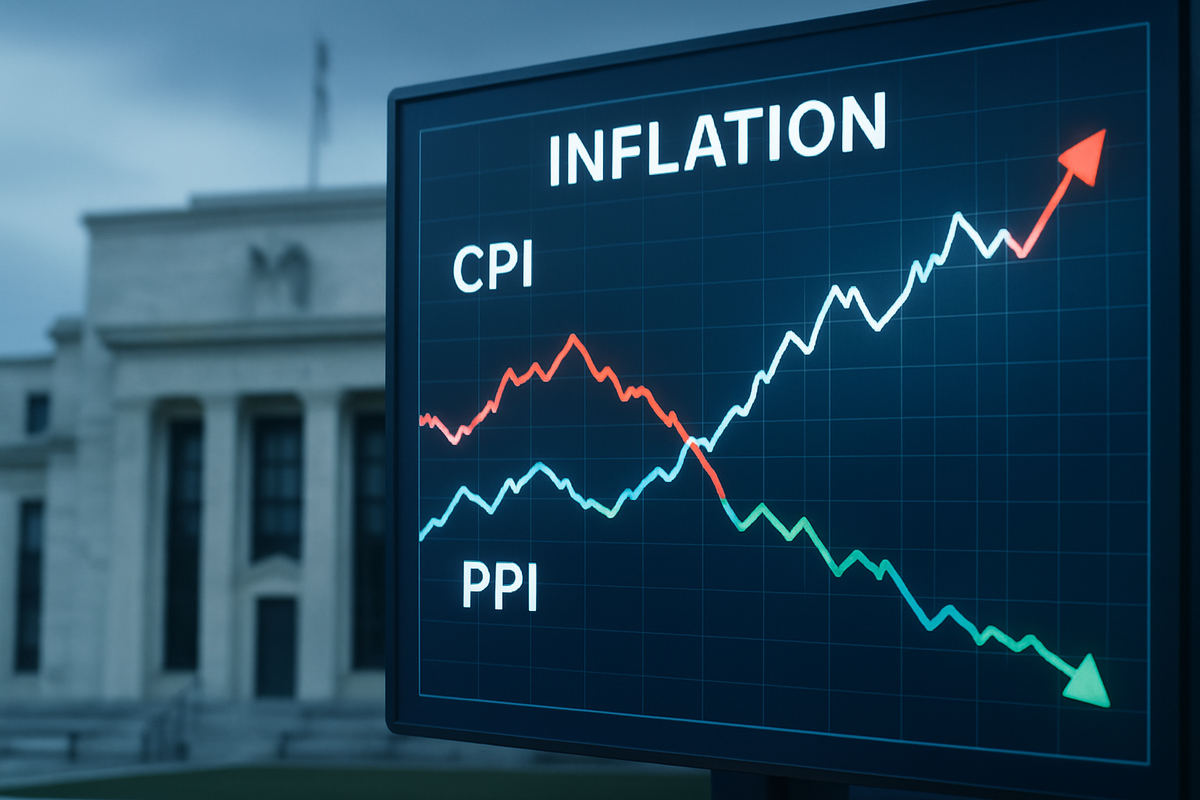
As financial markets brace for a pivotal week, all eyes are fixed on the impending release of the Consumer Price Index (CPI) and Producer Price Index (PPI) reports. These critical inflation gauges are poised to significantly influence the Federal Reserve's (Fed) monetary policy decisions, particularly regarding future interest rate adjustments. Investors, economists, and policymakers alike are keenly awaiting these figures, understanding that their implications could ripple across all sectors of the economy, dictating everything from borrowing costs to corporate profitability. The data will provide a crucial snapshot of inflationary pressures, offering insights into whether the Fed's aggressive tightening cycle has effectively cooled the economy or if more restrictive measures are still needed.
The anticipation surrounding these reports underscores the market's heightened sensitivity to inflation data. A higher-than-expected CPI, especially in its core measure (excluding volatile food and energy prices), could signal persistent inflationary pressures, potentially forcing the Fed to maintain a hawkish stance or even consider further rate hikes. Conversely, a softer reading might offer the central bank more flexibility, potentially paving the way for a pause or even a pivot in its tightening cycle. The stakes are incredibly high, as the Fed navigates the delicate balance between taming inflation and avoiding a significant economic downturn.
The Inflationary Pulse: What Happened and Why It Matters
The upcoming CPI and PPI reports are not just routine economic data releases; they are critical barometers of the nation's economic health and the effectiveness of current monetary policy. The Consumer Price Index (CPI) measures the average change over time in the prices paid by urban consumers for a market basket of consumer goods and services. The Producer Price Index (PPI), on the other hand, measures the average change over time in the selling prices received by domestic producers for their output. Both are crucial for understanding the trajectory of inflation from different points in the supply chain.
Economists are particularly focused on the core CPI, which strips out the volatile food and energy components, providing a clearer picture of underlying inflationary trends. The consensus expectation is for a modest rise in core CPI, but any deviation from this forecast could trigger significant market reactions. The timeline leading up to this moment has been characterized by the Federal Reserve's aggressive campaign of interest rate hikes, initiated to combat inflation that soared to multi-decade highs. Key players involved include the Federal Reserve's Federal Open Market Committee (FOMC), led by Chairman Jerome Powell, who has repeatedly emphasized the Fed's commitment to bringing inflation back down to its 2% target. Other stakeholders include major financial institutions, corporate executives, and everyday consumers, all of whom are directly impacted by inflation and interest rate changes. Initial market reactions are likely to be swift and pronounced, with equity markets, bond yields, and currency valuations all poised for volatility immediately following the data release. A hotter-than-expected report could lead to a sell-off in equities and a rise in bond yields, reflecting expectations of higher interest rates, while a cooler report might spark a relief rally.
Navigating the Tides: Potential Winners and Losers
The outcome of the CPI and PPI reports, and the Federal Reserve's subsequent actions, will inevitably create a landscape of winners and losers across the corporate world. Companies with strong pricing power and those in sectors less sensitive to interest rate fluctuations may emerge as relative winners. For instance, established consumer staples companies like Procter & Gamble (NYSE: PG) or Coca-Cola (NYSE: KO) often demonstrate resilience during inflationary periods, as consumers continue to purchase essential goods, and these companies can often pass on increased costs. Similarly, energy companies such as ExxonMobil (NYSE: XOM) or Chevron (NYSE: CVX) could benefit if energy prices remain elevated, contributing to overall inflation.
Conversely, companies heavily reliant on consumer discretionary spending or those with significant debt burdens are likely to face headwinds. Technology companies, particularly those with high growth but not yet profitable, like many in the software-as-a-service (SaaS) sector, could see their valuations pressured as higher interest rates increase the discount rate applied to their future earnings. Companies with substantial variable-rate debt, such as certain real estate investment trusts (REIT) or highly leveraged industrial firms, could see their financing costs surge, impacting profitability. Retailers like Target (NYSE: TGT) or Macy's (NYSE: M) might struggle if inflation erodes consumer purchasing power, leading to reduced sales volumes. Financial institutions, such as JPMorgan Chase (NYSE: JPM) or Bank of America (NYSE: BAC), could see mixed effects; while higher rates generally boost net interest margins, a significant economic slowdown triggered by aggressive tightening could lead to increased loan defaults.
Broader Implications and Industry Ripple Effects
The upcoming inflation reports are not isolated events but rather critical data points within a broader economic narrative. They fit squarely into the ongoing global struggle against persistent inflation, a trend exacerbated by supply chain disruptions, geopolitical tensions, and robust consumer demand in the wake of pandemic-era stimulus. The potential ripple effects on competitors and partners are significant. For instance, if inflation remains high, companies across various industries will continue to face elevated input costs, impacting their profit margins and potentially leading to further price increases for consumers. This could create a challenging environment for smaller businesses that lack the scale or pricing power of larger corporations.
Regulatory and policy implications are also substantial. A sustained period of high inflation could prompt governments to consider additional fiscal measures to support consumers, or even lead to calls for greater regulatory oversight of pricing practices in certain sectors. Historically, periods of high inflation, such as the 1970s, have often been followed by aggressive monetary tightening, leading to recessions. The Federal Reserve is acutely aware of these historical precedents and is attempting to engineer a "soft landing" – bringing inflation down without triggering a severe economic downturn. The current situation is unique, however, with a tight labor market coexisting with inflationary pressures, making the Fed's task particularly challenging. The reports will also influence global markets, as other central banks often take cues from the Fed's actions, potentially leading to synchronized monetary policy shifts worldwide.
What Comes Next: Navigating the Economic Crossroads
The immediate aftermath of the CPI and PPI reports will likely see significant market volatility as investors digest the data and recalibrate their expectations for the Federal Reserve's next moves. In the short term, a hotter-than-expected report could solidify expectations for further rate hikes, potentially leading to a continued sell-off in risk assets and a strengthening of the U.S. dollar. Conversely, a cooler report might spark a relief rally, as markets price in a more dovish Fed.
In the long term, businesses will need to consider strategic pivots and adaptations. Companies with robust balance sheets and efficient supply chains will be better positioned to weather persistent inflationary pressures or a potential economic slowdown. This might involve investing in automation to reduce labor costs, diversifying supply chains to mitigate future disruptions, or focusing on core competencies to improve efficiency. Market opportunities may emerge in sectors that are traditionally resilient during economic downturns, such as healthcare or utilities, or in companies that offer innovative solutions to combat inflation, such as those in renewable energy or efficiency technologies. Challenges will include managing rising input costs, navigating potential demand destruction from higher prices, and adapting to a potentially higher interest rate environment for an extended period. Potential scenarios range from a "soft landing" where inflation gradually subsides without a recession, to a "hard landing" involving a significant economic contraction if the Fed's tightening proves too aggressive.
Conclusion: A Defining Moment for the Market
The upcoming CPI and PPI reports represent a defining moment for the financial markets and the broader economy. They will provide crucial insights into the effectiveness of the Federal Reserve's monetary policy and the trajectory of inflation, which remains a primary concern for investors and consumers alike. The key takeaway from this period is the paramount importance of inflation data in shaping central bank policy and, consequently, market sentiment. Investors should be prepared for continued volatility and remain agile in their strategies.
Moving forward, the market will be closely watching not only subsequent inflation reports but also the Federal Reserve's communications and actions. Any shifts in the Fed's rhetoric or policy stance will be scrutinized for clues about the future path of interest rates. Additionally, investors should monitor corporate earnings reports for signs of how companies are managing inflationary pressures and adapting to the evolving economic landscape. The lasting impact of these inflation reports will be felt across various sectors, influencing investment decisions, corporate strategies, and consumer behavior for months to come. The ability of the economy to navigate these inflationary headwinds will ultimately determine the path to sustainable growth and stability.





